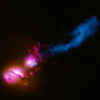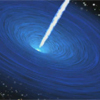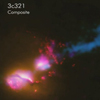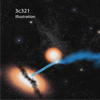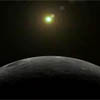CXC Home | Search | Help | Image Use Policy | Latest Images | Privacy | Accessibility | Glossary | Q&A
Tour of 3C321
Quicktime MPEG
In 3C321, a jet from a black hole in one of the galaxies is pummeling its neighbor galaxy, the first time this type of galactic violence has ever been seen. The jet could bring big trouble for any planets in its path, but could also trigger a burst of star formation in its wake. Beginning with a wide-field view of X-ray and radio emission, we see that the jets from the black hole extend amazingly far, about 1.7 million light-years. Next, we zoom into the two galaxies where most of the action is happening. Radio emission from the Very Large Array and Merlin telescopes, optical and ultraviolet data from Hubble, and X-rays from Chandra all reveal different features of this system. The combined image of all of these data shows how the jet from the galaxy on the lower left impacts the companion galaxy to the upper right. The jet hits the galaxy's edge and is then disrupted and deflected, much like how a stream of water from a hose will splay out after hitting a wall at an angle.
[Runtime: 1:03]
Quicktime MPEG
In 3C321, a jet from a black hole in one of the galaxies is pummeling its neighbor galaxy, the first time this type of galactic violence has ever been seen. The jet could bring big trouble for any planets in its path, but could also trigger a burst of star formation in its wake. Beginning with a wide-field view of X-ray and radio emission, we see that the jets from the black hole extend amazingly far, about 1.7 million light-years. Next, we zoom into the two galaxies where most of the action is happening. Radio emission from the Very Large Array and Merlin telescopes, optical and ultraviolet data from Hubble, and X-rays from Chandra all reveal different features of this system. The combined image of all of these data shows how the jet from the galaxy on the lower left impacts the companion galaxy to the upper right. The jet hits the galaxy's edge and is then disrupted and deflected, much like how a stream of water from a hose will splay out after hitting a wall at an angle.
[Runtime: 1:03]
( Credit: X-ray: NASA/CXC/CfA/D.Evans et al.; Optical/UV: NASA/STScI; Radio: NSF/VLA/CfA/D.Evans et al., STFC/JBO/MERLIN)
Animation of 3C321
MP4 (34.4MB) Quicktime MPEG
This animation of 3C321 begins with a close-up of the supermassive black hole in the center of the main galaxy. Hot gas is falling towards the black hole via a blue disk. Some of this material is swallowed by the black hole, but much of it is ejected in a narrow jet of particles traveling at almost the speed of light. The camera then pulls back to show stars and a dust lane in the main galaxy. As the field of view continues to increase in size, the companion galaxy becomes visible as it swings into the path of the jet from the main galaxy. The jet is deflected and disrupted by the impact with the companion galaxy. [Runtime: 0:46]
(Credits: NASA/STScI/G. Bacon)
Animation Stills
MP4 (34.4MB) Quicktime MPEG
This animation of 3C321 begins with a close-up of the supermassive black hole in the center of the main galaxy. Hot gas is falling towards the black hole via a blue disk. Some of this material is swallowed by the black hole, but much of it is ejected in a narrow jet of particles traveling at almost the speed of light. The camera then pulls back to show stars and a dust lane in the main galaxy. As the field of view continues to increase in size, the companion galaxy becomes visible as it swings into the path of the jet from the main galaxy. The jet is deflected and disrupted by the impact with the companion galaxy. [Runtime: 0:46]
(Credits: NASA/STScI/G. Bacon)
Animation Stills
Multiwavelength Images of 3C321
Quicktime MPEG
This series of images shows how 3C321 looks in a variety of types of radiation. Beginning with a wide-field view of X-ray and radio emission, the image reveals jets that extend for about 1.7 million light years before zooming into the central two galaxies. Optical and ultraviolet data from Hubble, radio emission from the Very Large Array and MERLIN, and X-rays from Chandra combine to reveal how the jet from the main galaxy on the lower left is striking its companion galaxy to the upper right. The jet impacts the companion galaxy at its edge and is then disrupted and deflected, much like how a stream of water from a hose will splay out after hitting a wall at an angle.
[Runtime: 0:23] (Credits: X-ray: NASA/CXC/CfA/D.Evans et al.; Optical/UV: NASA/STScI; Radio: NSF/VLA/CfA/D.Evans et al., STFC/JBO/MERLIN)
Quicktime MPEG
This series of images shows how 3C321 looks in a variety of types of radiation. Beginning with a wide-field view of X-ray and radio emission, the image reveals jets that extend for about 1.7 million light years before zooming into the central two galaxies. Optical and ultraviolet data from Hubble, radio emission from the Very Large Array and MERLIN, and X-rays from Chandra combine to reveal how the jet from the main galaxy on the lower left is striking its companion galaxy to the upper right. The jet impacts the companion galaxy at its edge and is then disrupted and deflected, much like how a stream of water from a hose will splay out after hitting a wall at an angle.
[Runtime: 0:23] (Credits: X-ray: NASA/CXC/CfA/D.Evans et al.; Optical/UV: NASA/STScI; Radio: NSF/VLA/CfA/D.Evans et al., STFC/JBO/MERLIN)
Comparison of 3C321 Composite to Artist's Illustration
Quicktime MPEG
This sequence compares the composite image of 3C321 to an artist's illustration of the system, showing the main galaxy and the companion galaxy. A jet of particles generated by a supermassive black hole at the center of the main galaxy is striking the companion galaxy. The jet is disrupted and deflected by this impact. The key features of this system are labeled in the final view.
[Runtime: 0:14]
(Credits: Image: X-ray: NASA/CXC/CfA/D.Evans et al.; Optical/UV: NASA/STScI; Radio: NSF/VLA/CfA/D.Evans et al., STFC/JBO/MERLIN; Illustration: NASA/CXC/M. Weiss)
Quicktime MPEG
This sequence compares the composite image of 3C321 to an artist's illustration of the system, showing the main galaxy and the companion galaxy. A jet of particles generated by a supermassive black hole at the center of the main galaxy is striking the companion galaxy. The jet is disrupted and deflected by this impact. The key features of this system are labeled in the final view.
[Runtime: 0:14]
(Credits: Image: X-ray: NASA/CXC/CfA/D.Evans et al.; Optical/UV: NASA/STScI; Radio: NSF/VLA/CfA/D.Evans et al., STFC/JBO/MERLIN; Illustration: NASA/CXC/M. Weiss)

Interview Clips with Dr. Daniel Evans
In this segment, Dr. Daniel Evans of the Harvard-Smithsonian Center for Astrophysics discusses the 3C321 result and its significance. Dr. Evans and his collaborators made the discovery by combining information from both space-based NASA missions as well as radio observations from the ground.
[Runtime: 0:25]
[Total running time = 1:40 sec]
(Credit: NASA/CXC/A. Hobart)
Part 1 |
Part 2 |
Part 3 |
Part 4 |
||
QuickTime |
|||||
Mpeg |
|||||
Broadcast Quality |
|||||
[Total running time = 1:40 sec]
(Credit: NASA/CXC/A. Hobart)
Chandra Spacecraft Animation
Quicktime MPEG
This artist's conception begins with the Chandra X-ray Observatory as it passes in front of the Moon. Chandra, one of NASA's "Great Observatories," does not orbit closely around the Earth. Instead, its highly elliptical orbit takes as far as one-third the distance to the Moon. Operating in space since 1999, Chandra detects and images X-ray sources that lie within our Solar System to those billions of light years away. The results from Chandra help explore high-energy phenomena and provide insights into the Universe's structure and evolution. Available in High Def by request.
[Runtime: 0:32]
(Credit: NASA/CXC/D. Berry)
Quicktime MPEG
This artist's conception begins with the Chandra X-ray Observatory as it passes in front of the Moon. Chandra, one of NASA's "Great Observatories," does not orbit closely around the Earth. Instead, its highly elliptical orbit takes as far as one-third the distance to the Moon. Operating in space since 1999, Chandra detects and images X-ray sources that lie within our Solar System to those billions of light years away. The results from Chandra help explore high-energy phenomena and provide insights into the Universe's structure and evolution. Available in High Def by request.
[Runtime: 0:32]
(Credit: NASA/CXC/D. Berry)
Return to 3C321 (December 17, 2007)


